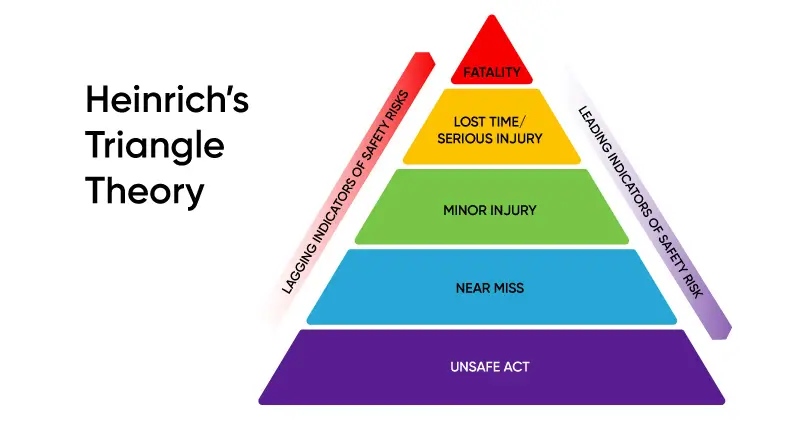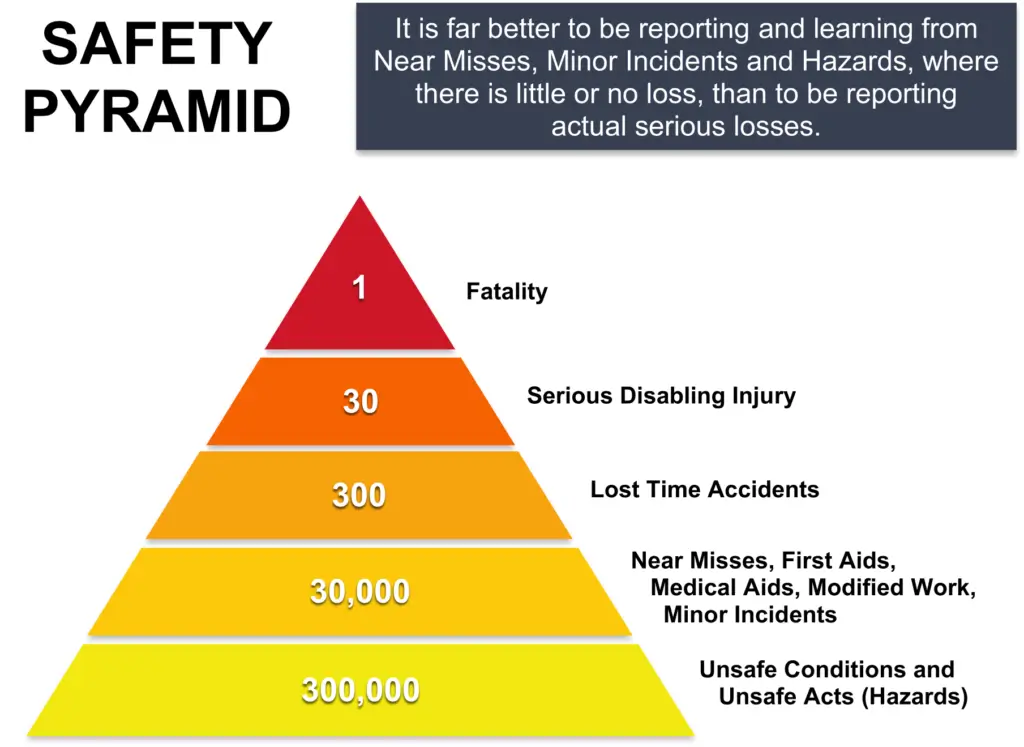In today’s fast-paced work environments, prioritizing safety is more crucial than ever. The Safety Pyramid, a time-tested framework developed in the 1930s by H.W. Heinrich, offers a strategic approach to reducing workplace accidents by focusing on the foundational elements of occupational health and safety.
This blog delves into the importance of constructing a Safety Pyramid within the workplace, highlighting its role in promoting a proactive safety culture, enabling data-driven decision-making, and fostering continuous improvement.
Through a detailed exploration of its principles and practical applications, we aim to provide valuable insights into how organizations can effectively mitigate risks and protect their workforce.

Understanding the Safety Pyramid
The Safety Pyramid, also known as Heinrich’s Safety Pyramid or the Safety Triangle, is a foundational concept in the field of occupational health and safety. Developed in the 1930s by H.W. Heinrich, an employee of the Traveler’s Insurance Company, this theory has significantly influenced how organizations approach accident prevention and safety management.
Below, we delve into the details of the Safety Pyramid, its theoretical basis, application in incident management, critiques, and the relevance of recent studies to its foundational principles.
Theoretical Basis of the Safety Pyramid
The Safety Pyramid is visually represented as a triangle divided into tiers, each indicating a different category of workplace incidents. At the base of the pyramid are near-misses, followed by minor injuries, and then major injuries, with fatalities at the top. The concept is rooted in Heinrich’s Law, which posits a predictable ratio between these categories: for every major injury, there are 29 minor injuries and 300 near-misses. This ratio suggests that a large number of less severe incidents precede a small number of severe incidents.
Heinrich’s most cited figure suggests that 88% of all workplace injuries and incidents result from unsafe acts by individuals. However, Heinrich emphasized the importance of addressing environmental hazards and unsafe conditions, not just worker behaviors.
Application in Incident Management
The practical application of the Safety Pyramid in incident management involves focusing on the base of the pyramid (near-misses and minor injuries) to prevent more severe incidents higher up. By identifying, reporting, and addressing these lower-tier incidents, organizations can theoretically reduce the occurrence of major injuries and fatalities. This approach encourages a proactive safety culture, where all incidents are seen as opportunities for improvement rather than just outcomes to be avoided.
Critiques of the Safety Pyramid
Critics of the Safety Pyramid argue that it overemphasizes the role of individual behavior in causing accidents, potentially neglecting systemic issues and the complexity of workplace safety. This critique points to the need for a holistic approach to safety that considers the entire workplace system, including organizational, environmental, and human factors.
Recent Studies and Relevance
Recent research, including a 2018 study by NIOSH, has sought to validate Heinrich’s conclusions. This study focused on the mining industry, analyzing data over 13 years from thousands of establishments to determine if lower-severity incidents could predict fatalities. The findings supported the existence of the Safety Pyramid, showing that minor incidents could indeed serve as indicators for more severe accidents, albeit with nuances depending on how injury severity is defined.
The study highlighted that the applicability of the Safety Pyramid might vary based on the metrics used to define injury severity, suggesting that while the pyramid’s concept holds value, its implementation must be tailored to specific industry contexts and definitions of injury severity.

The Importance of Building a Safety Pyramid in the Workplace
The Safety Pyramid, conceptualized by H.W. Heinrich in the 1930s, remains a cornerstone in the field of occupational health and safety. Its enduring relevance underscores the critical role it plays in fostering safer work environments.
By illustrating the relationship between non-injury incidents, minor injuries, and major injuries, the Safety Pyramid provides a framework for understanding and mitigating workplace hazards. This article explores the significance of building a Safety Pyramid in the workplace and how it can lead to a more proactive safety culture.
A Proactive Approach to Safety
At the heart of the Safety Pyramid is the principle of proactivity. By focusing on the base of the pyramid—near misses and minor injuries—organizations can identify and rectify potential hazards before they escalate into more serious incidents or fatalities.
This approach shifts the focus from reactive measures, which address issues after an accident occurs, to preventive measures, which aim to avoid accidents altogether.
Enhancing Safety Culture
Implementing the Safety Pyramid framework helps cultivate a safety-conscious culture within an organization. It encourages the reporting and investigation of all incidents, including near misses, which are often overlooked. Recognizing and analyzing these incidents not only prevents future accidents but also fosters a culture where safety is prioritized, and every employee feels responsible for maintaining it.
Data-Driven Decision Making
The tiered structure of the Safety Pyramid enables organizations to collect data on various types of incidents, providing insights into the most common risks and hazards in the workplace. This data-driven approach allows for more targeted and effective safety interventions, policies, and training programs, tailored to address the specific needs and risks of the organization.
Continuous Improvement
Building a Safety Pyramid in the workplace is not a one-time effort but a continuous process of improvement. It requires regular review and adjustment of safety practices based on the analysis of incident data and feedback from employees. This iterative process ensures that safety measures remain effective and relevant, adapting to changes in the workplace environment, operations, and industry standards.
Overcoming Criticisms with a Balanced Approach
While the Safety Pyramid has faced criticism for potentially oversimplifying the complexities of workplace safety and overemphasizing individual behavior, these issues can be mitigated by adopting a balanced approach. This involves recognizing the interplay between human behavior, environmental conditions, and organizational factors in causing accidents.
By addressing all these aspects, organizations can effectively utilize the Safety Pyramid while acknowledging and addressing its limitations.
Conclusion
The Safety Pyramid remains a valuable tool in understanding and managing workplace safety, emphasizing the importance of addressing minor incidents to prevent more severe outcomes. However, its application should be nuanced, taking into account the complexities of modern workplaces and the limitations of focusing solely on individual behaviors.
By integrating the principles of the Safety Pyramid with a comprehensive approach to safety management, organizations can better protect their workers and create safer work environments.

